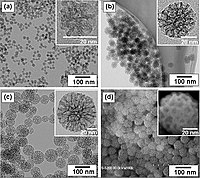
Photo from wikipedia
Abstract Pretreatment steps carefully designed are essential to achieve a more integral and profitable use of plant biomasses in their conversion into building blocks to produce bioethanol and biomaterials. In… Click to show full abstract
Abstract Pretreatment steps carefully designed are essential to achieve a more integral and profitable use of plant biomasses in their conversion into building blocks to produce bioethanol and biomaterials. In this work, lignin extraction from corn biomass was optimized using a design of experiments (DOE) applied to a sequential acid-alkali pretreatment, varying temperature, time, and NaOH concentration in the alkali step. Selective extraction of lignin allowed the preparation of lignin nanoparticles, at the same time that it favored glucose release by hydrolysis of the cellulosic matrix. According to DOE results, alkali concentration was the most relevant factor for lignin removal and 2% NaOH, at 90 to 95 °C for 20 to 35 min would be enough to achieve less than 10% of residual lignin in the solid. These conditions were experimentally validated and resulted in a hydrolysis yield of 87.4 ± 7.3% and in a liquor containing approximately 50% of the initial lignin content. A great quantity of this neat lignin (92.9 ± 6.3%) was recovered by non-solvent addition as spherical nanoparticles, with a diameter smaller than 100 nm, and stable in a large pH range (5 to 11). Therefore, the optimization presented herewith resulted in lignin valorization by the suitable fabrication of value-added lignin nanoparticles, concomitantly to improved hydrolysis yields of cellulose aiming at bioethanol production.
Journal Title: Industrial Crops and Products
Year Published: 2019
Link to full text (if available)
Share on Social Media: Sign Up to like & get
recommendations!